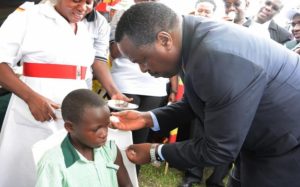
Around the world, more than 200,000 women die of cervical cancer each year. The disease is primarily caused by human papillomavirus (HPV). To prevent the cancer, researchers have developed HPV vaccines that are given to girls starting at age 9. Girls in many middle- to low-income countries usually receive the vaccines through programs in their primary schools. However, in places such as sub-Saharan Africa, up to 23 percent of young girls may not be attending school, which means millions of them won’t receive the vaccine and could be at risk for cervical cancer. To address this gap, researchers from the University of Minnesota School of Public Health published a commentary for researchers and health officials offering strategies for determining how to best vaccinate young out-of-school girls.
“The main point we’re making in this paper is that there are promising methods and approaches to consider for reaching girls who are not in school with this life-saving vaccine,” says lead author and PhD student Kimberly Bonner.
The commentary was co-authored by Bonner’s advisor, Assistant Professor Nicole Basta, and published in the journal Vaccine.

The researchers outlined four main considerations in developing vaccination programs for out-of-school girls.
Bonner said health care officials need to begin with accurately identifying and counting the number of out-of-school girls in their communities in order to obtain enough vaccine for everyone.
“Health care officials and clinics can use national surveys to get a general idea of how many girls need to be vaccinated, but they also have to look at it on the local level to make sure they’re not missing anyone,” says Bonner. “They can do this by talking to local school administrators, civil officials, and religious leaders to quantify the number of vaccine-eligible, out-of-school girls in their communities.”
Next, the researchers recommended identifying obstacles that block out-of-school girls from getting vaccinated.
“We need to determine their awareness of the vaccine, the barriers they face in receiving it, and how they want to receive it because what works for girls in school may not work for them,” says Bonner.
The commentary also stated the importance of providing out-of-school girls, their parents, and their communities with accurate, effective communication regarding HPV and the vaccine.
“A study in Tanzania of HPV vaccination uptake found that insufficient information and misconceptions of vaccine were the two major reasons why people didn’t receive it,” says Bonner. “This means that when considering hard-to-reach populations — such as out-of-school girls — targeted strategies may be needed to properly inform them.”
Lastly, the authors suggested that health care officials use alternative models for vaccination, such as “piggybacking” HPV vaccinations onto other services.
“For example, in South Africa, they’ve successfully trialled screening mothers for cervical cancer in conjunction with vaccinating their daughters,” says Bonner. “Also, one of the HPV vaccines has regulatory approval to be used without refrigeration for up to three days, which means it’s possible to vaccinate people in more remote or rural areas lacking electricity.”
Bonner is continuing to research the subject by assisting Basta on studies examining barriers to HPV vaccination is rural Uganda.
